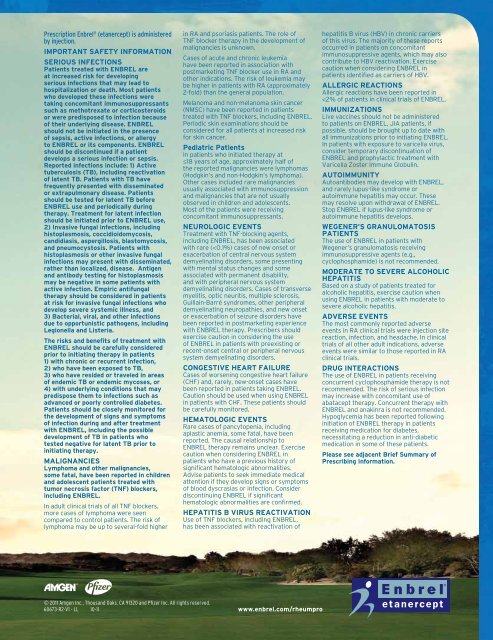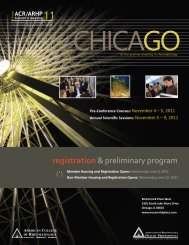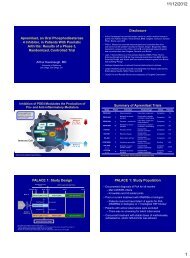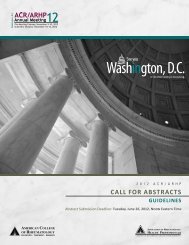- Page 1 and 2:
program B O O K Pre-Conference Cour
- Page 3 and 4:
program B O O K ABOUT ACR/ARHP EDUC
- Page 5 and 6:
TABLE OF CONTENTS POLICIES Copyrigh
- Page 7 and 8:
TABLE OF CONTENTS ACR Immunology Up
- Page 9 and 10:
TABLE OF CONTENTS Vasculitis Poster
- Page 11 and 12:
However, the ACR continues to requi
- Page 13 and 14:
MEETING NAVIGATION GUIDE To navigat
- Page 15 and 16:
Newsroom Located in room W175c, use
- Page 17:
Guided Poster Tours Guided poster t
- Page 20 and 21:
FRIDAY November 4, 2011 9:15 am Ult
- Page 22 and 23:
SATURDAY, NOVEMBER 5, 2011 12:00 -
- Page 24 and 25:
SATURDAY November 5, 2011 8:35 am T
- Page 26 and 27:
SATURDAY November 5, 2011 Pain: Pat
- Page 28 and 29:
SUNDAY November 6, 2011 SUNDAY, NOV
- Page 30 and 31:
SUNDAY November 6, 2011 Upon comple
- Page 32 and 33:
EXHIBITS 10:00 am - 5:00 pm INNOVAT
- Page 34 and 35:
SUNDAY November 6, 2011 ARHP SPECIA
- Page 36 and 37:
SUNDAY November 6, 2011 W179b Rheum
- Page 38 and 39:
3:15 pm 732. Notch Signaling Pathwa
- Page 40 and 41:
SUNDAY November 6, 2011 3:15 pm 756
- Page 42 and 43:
SUNDAY November 6, 2011 Children’
- Page 44 and 45:
SUNDAY November 6, 2011 3:00 pm 791
- Page 46 and 47:
3:30 pm Demonstration and Practice
- Page 48 and 49:
Yasser M. El Miedany 1 , Maha El Ga
- Page 50 and 51:
SUNDAY November 6, 2011 48 Musculos
- Page 52 and 53:
SUNDAY November 6, 2011 5:15 pm 852
- Page 54 and 55:
SUNDAY November 6, 2011 52 4:55 pm
- Page 56 and 57:
MONDAY, NOVEMBER 7, 2011 ACR/ARHP R
- Page 58 and 59:
MONDAY November 7, 2011 W185a Scler
- Page 60 and 61:
MONDAY November 7, 2011 Upon comple
- Page 62 and 63:
Upon completion of this session, pa
- Page 64 and 65:
MONDAY November 7, 2011 W187b Basic
- Page 66 and 67:
MONDAY November 7, 2011 2:30 pm Cel
- Page 68 and 69:
MONDAY November 7, 2011 Indianapoli
- Page 70 and 71:
3:45 pm 1628. Association of Knee P
- Page 72 and 73:
MONDAY November 7, 2011 Glostrup, C
- Page 74 and 75:
MONDAY November 7, 2011 3:33 pm A R
- Page 76 and 77:
MONDAY November 7, 2011 4:30 pm Ris
- Page 78 and 79:
Institutet, Stockholm, Sweden, 6 Un
- Page 80 and 81:
5:45 pm 1700. Successful Dose De-Es
- Page 82 and 83:
MONDAY November 7, 2011 Michigan, A
- Page 84 and 85:
MONDAY November 7, 2011 4:45 pm 172
- Page 86 and 87:
MONDAY November 7, 2011 5:25 pm Imp
- Page 88 and 89:
TUESDAY November 8, 2011 ARHP CONCU
- Page 90 and 91:
TUESDAY November 8, 2011 9:25 am Is
- Page 92 and 93:
ACR PRACTICE ISSUE 9:30 - 10:30 am
- Page 94 and 95:
TUESDAY November 8, 2011 noon 2431.
- Page 96 and 97:
TUESDAY November 8, 2011 W186b Vasc
- Page 98 and 99:
ACR CLINICAL SYMPOSIA 2:30 - 4:00 p
- Page 100 and 101:
TUESDAY November 8, 2011 3:45 pm 24
- Page 102 and 103:
TUESDAY November 8, 2011 University
- Page 104 and 105:
TUESDAY November 8, 2011 and Oncolo
- Page 106 and 107:
Italy, 3 Hospital Universitario La
- Page 108 and 109:
3:10 pm Case Study Diane V. Lacaill
- Page 110 and 111:
• discuss the evidence to support
- Page 112 and 113:
TUESDAY November 8, 2011 4:45 pm 25
- Page 114 and 115:
5:15 pm 2532. Selection of Patients
- Page 116 and 117:
TUESDAY November 8, 2011 ACR/ARHP C
- Page 118 and 119:
WEDNESDAY, NOVEMBER 9, 2011 ACR/ARH
- Page 120 and 121:
9:00 am Mechanisms of Thrombosis in
- Page 122 and 123:
WEDNESDAY November 9, 2011 A. Kopec
- Page 124 and 125:
WEDNESDAY November 9, 2011 9:15 am
- Page 126 and 127:
WEDNESDAY November 9, 2011 9:45 am
- Page 128 and 129:
WEDNESDAY November 9, 2011 11:45 am
- Page 130 and 131:
WEDNESDAY November 9, 2011 Graduate
- Page 132 and 133:
11:00 am The Process: Defining Appr
- Page 134 and 135:
ACR Poster Session A 11. Myocardial
- Page 136 and 137:
ACR Poster Session A 37. Regulation
- Page 138 and 139:
ACR Poster Session A 64. Interleuki
- Page 140 and 141:
ACR Poster Session A Mexico City, M
- Page 142 and 143:
ACR Poster Session A 121. An Analys
- Page 144 and 145:
ACR Poster Session A 146. National
- Page 146 and 147:
ACR Poster Session A 165. Genome-Wi
- Page 148 and 149:
ACR Poster Session A 185. US Examin
- Page 150 and 151:
ACR Poster Session A Jones 1 , Andr
- Page 152 and 153:
ACR Poster Session A Gerald J. D. H
- Page 154 and 155:
ACR Poster Session A 258. Etanercep
- Page 156 and 157:
ACR Poster Session A GA, 6 Hospital
- Page 158 and 159:
ACR Poster Session A 305. Pathway-B
- Page 160 and 161:
ACR Poster Session A 328. Near Miss
- Page 162 and 163:
ACR Poster Session A 351. A Novel M
- Page 164 and 165:
ACR Poster Session A Sugihara 6 , K
- Page 166 and 167:
ACR Poster Session A 398. Rituximab
- Page 168 and 169:
ACR Poster Session A & Johnson Phar
- Page 170 and 171:
ACR Poster Session A 436. Predicted
- Page 172 and 173:
ACR Poster Session A Tomomi Tsuru 1
- Page 174 and 175:
ACR Poster Session A 479. Follow up
- Page 176 and 177:
ACR Poster Session A 496. A Chimeri
- Page 178 and 179:
ACR Poster Session A 518. Associati
- Page 180 and 181:
ACR Poster Session A Piestany, Slov
- Page 182 and 183:
ACR Poster Session A 576. Fn14 Defi
- Page 184 and 185:
ACR Poster Session A 593. Plasma Le
- Page 186 and 187:
ACR Poster Session A 611. Why Do Lu
- Page 188 and 189:
ACR Poster Session A 634. Associati
- Page 190 and 191:
ACR Poster Session A Alarcon-Riquel
- Page 192 and 193:
ACR Poster Session A Laboratories,
- Page 194 and 195:
ACR Poster Session A Movsisyan, Lid
- Page 196 and 197:
ACR Poster Session A Th1 Cells Expa
- Page 198 and 199:
ACR/ARHP Poster Session B College o
- Page 200 and 201:
ACR/ARHP Poster Session B 920. Econ
- Page 202 and 203:
ACR/ARHP Poster Session B Study. A.
- Page 204 and 205:
ACR/ARHP Poster Session B 974. Dise
- Page 206 and 207:
ACR/ARHP Poster Session B 1001. Mic
- Page 208 and 209:
ACR/ARHP Poster Session B 206 Khann
- Page 210 and 211:
ACR/ARHP Poster Session B 208 Pulmo
- Page 212 and 213:
ACR/ARHP Poster Session B Swearinge
- Page 214 and 215:
ACR/ARHP Poster Session B 212 Felds
- Page 216 and 217:
ACR/ARHP Poster Session B 214 Corbi
- Page 218 and 219:
ACR/ARHP Poster Session B 1161. End
- Page 220 and 221:
ACR/ARHP Poster Session B 1182. Uri
- Page 222 and 223:
ACR/ARHP Poster Session B 1205. A S
- Page 224 and 225:
ACR/ARHP Poster Session B 222 Murth
- Page 226 and 227:
ACR/ARHP Poster Session B San Diego
- Page 228 and 229:
ACR/ARHP Poster Session B 1266. Eva
- Page 230 and 231:
ACR/ARHP Poster Session B 1296. Pat
- Page 232 and 233:
ACR/ARHP Poster Session B 230 1320.
- Page 234 and 235:
ACR/ARHP Poster Session B 1348. Syn
- Page 236 and 237:
ACR/ARHP Poster Session B 1375. Ant
- Page 238 and 239:
ACR/ARHP Poster Session B 1398. Cli
- Page 240 and 241:
ACR/ARHP Poster Session B Baltimore
- Page 242 and 243:
ACR/ARHP Poster Session B 1451. Ele
- Page 244 and 245:
ACR/ARHP Poster Session B Sclerosis
- Page 246 and 247:
ACR/ARHP Poster Session B 1496. Evi
- Page 248 and 249:
ACR/ARHP Poster Session B 1518. Pro
- Page 250 and 251:
ACR/ARHP Poster Session B Hagen 1 ,
- Page 252 and 253:
ACR/ARHP Poster Session B ARHP Clin
- Page 254 and 255:
ACR/ARHP Poster Session C Karl Eger
- Page 256 and 257:
ACR/ARHP Poster Session C Tampere S
- Page 258 and 259:
ACR/ARHP Poster Session C 256 1 Jun
- Page 260 and 261:
ACR/ARHP Poster Session C Universit
- Page 262 and 263:
ACR/ARHP Poster Session C 1864. Epi
- Page 264 and 265:
ACR/ARHP Poster Session C 262 Hospi
- Page 266 and 267:
ACR/ARHP Poster Session C 2 Biogen
- Page 268 and 269:
ACR/ARHP Poster Session C 1945. Cir
- Page 270 and 271:
ACR/ARHP Poster Session C 268 1974.
- Page 272 and 273:
ACR/ARHP Poster Session C 2003. Eff
- Page 274 and 275:
ACR/ARHP Poster Session C Hosp Gast
- Page 276 and 277:
ACR/ARHP Poster Session C Toronto,
- Page 278 and 279:
ACR/ARHP Poster Session C Francisco
- Page 280 and 281:
ACR/ARHP Poster Session C 2105. Inc
- Page 282 and 283:
ACR/ARHP Poster Session C Universit
- Page 284 and 285:
ACR/ARHP Poster Session C 282 2151.
- Page 286 and 287:
ACR/ARHP Poster Session C 284 2175.
- Page 288 and 289:
ACR/ARHP Poster Session C 286 2196.
- Page 290 and 291:
ACR/ARHP Poster Session C 2217. Lon
- Page 292 and 293:
ACR/ARHP Poster Session C Research
- Page 294 and 295:
ACR/ARHP Poster Session C 2258. sIL
- Page 296 and 297:
ACR/ARHP Poster Session C 2290. The
- Page 298 and 299:
ACR/ARHP Poster Session C Universit
- Page 300 and 301:
ACR/ARHP Poster Session C 2345. IL-
- Page 302 and 303:
ACR/ARHP Poster Session C 2376. Gra
- Page 304 and 305:
ACR/ARHP Poster Session C 2399. Spe
- Page 306 and 307:
REF Industry Roundtable-supported S
- Page 308 and 309:
REF Industry Roundtable-supported S
- Page 310 and 311:
Industry-supported POST-CONFERENCE
- Page 312 and 313:
CERTIFICATES OF CME CREDIT OR PARTI
- Page 314 and 315:
2011 ACR/ARHP Annual Meeting Leader
- Page 316 and 317:
2011 ACR/ARHP Annual Meeting Leader
- Page 318 and 319:
EXHIBITORS Abbott Pharmaceuticals B
- Page 320 and 321:
EXHIBITORS Lippincott, Williams and
- Page 322 and 323:
acknowledgements The ACR, the ARHP
- Page 324 and 325:
Invited Speaker /Moderator Index 32
- Page 326 and 327:
Invited Speaker /Moderator Index 32
- Page 328 and 329:
Invited Speaker /Moderator Index Ev
- Page 330 and 331:
Invited Speaker /Moderator Index 32
- Page 332 and 333:
Invited Speaker /Moderator Index 33
- Page 334 and 335:
Invited Speaker /Moderator Index Mu
- Page 336 and 337:
Invited Speaker /Moderator Index Om
- Page 338 and 339:
Invited Speaker /Moderator Index St
- Page 340 and 341:
Invited Speaker /Moderator Index Wi
- Page 342 and 343:
aBSTRACT author Index 340 Alpers, C
- Page 344 and 345:
aBSTRACT author Index Bawa, WA 259
- Page 346 and 347:
aBSTRACT author Index 344 Broder, A
- Page 348 and 349:
aBSTRACT author Index 346 Chaves, L
- Page 350 and 351:
aBSTRACT author Index 348 Dalbeth,
- Page 352 and 353:
aBSTRACT author Index Eastman, PS 3
- Page 354 and 355:
aBSTRACT author Index 352 Fragoso-L
- Page 356 and 357: aBSTRACT author Index Gordon, C 4,
- Page 358 and 359: aBSTRACT author Index Hemmati, I 13
- Page 360 and 361: aBSTRACT author Index 358 Ishigatsu
- Page 362 and 363: aBSTRACT author Index 360 Keeling,
- Page 364 and 365: aBSTRACT author Index 362 Kumar, V
- Page 366 and 367: aBSTRACT author Index 364 Lim, M 13
- Page 368 and 369: aBSTRACT author Index 366 Marshall,
- Page 370 and 371: aBSTRACT author Index 368 MMF/AZA L
- Page 372 and 373: aBSTRACT author Index 370 Noel, D 1
- Page 374 and 375: aBSTRACT author Index 372 Pawlita,
- Page 376 and 377: aBSTRACT author Index 374 Ramos, I
- Page 378 and 379: aBSTRACT author Index 376 Rönnblom
- Page 380 and 381: aBSTRACT author Index 378 Shaykevic
- Page 382 and 383: aBSTRACT author Index Su, J 22, 139
- Page 384 and 385: aBSTRACT author Index 382 Tomcik, M
- Page 386 and 387: aBSTRACT author Index 384 Villeneuv
- Page 388 and 389: aBSTRACT author Index 386 Wu, X 650
- Page 390 and 391: abstract keyword Index 388 18FDG PE
- Page 392 and 393: abstract keyword Index 2092, 2113,
- Page 394 and 395: abstract keyword Index 392 macropha
- Page 396 and 397: abstract keyword Index 387, 388, 38
- Page 398 and 399: Abstract Moderator disclosure A Ano
- Page 400 and 401: Abstract Moderator disclosure Jonas
- Page 402 and 403: V van der Heijde, Desiree, MD, PhD
- Page 404 and 405: Notes 402 2011 Program Book
- Page 408: In appropriate patients with psoria





